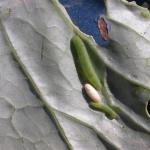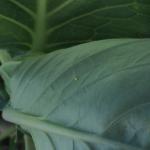Caterpillars in Brassica Crops
The major caterpillars on Brassicas – generally known as ‘worms in cabbage’ – include three species that differ in size and feeding habits, as well as how susceptible they are to certain insecticides. Getting acquainted with the pests helps you to know what kind of damage to expect and what to look for.
Imported cabbageworm; cabbage butterfly (Pieris rapae).
This familiar white butterfly can be seen in the daytime fluttering around cole crop fields. Each forewing has a dark border and one or two round black spots. Eggs are laid singly on the underside of leaves, about 1/8 inch in length, light green and slightly elongated, standing upright. The larvae, called imported cabbageworm, is graygreen, slightly fuzzy, and sluggish. Feeding and resting occur on the underside of leaves, and larvae feed more heavily in the head of cabbage or broccoli as they grow. The overwintering stage is the crysalis (pupa), which is green or brown, smooth with three pointed ridges on its back. There are 3-4 generations per year. For more information on imported cabbageworm, click here.
Diamondback moth (Plutella xylostella).
The adult moths are tiny (<1/2 inch), light brown, and rest with their wings folded together like a tent. Adults are weak fliers, but populations are known to disperse long distances on wind and annually reinvade areas well into Canada. Eggs are laid singly or in small clusters. The caterpillars are smaller, light green, appear more segmented and more pointed in shape. When disturbed they wiggle vigorously and may drop off the plant on a string of silk. Feeding causes small, round holes and tends to be spread across the foliage and not necessarily concentrated in the head. They overwinter in crop residue, but may also enter the region by migrating from southern states. For more information on the diamondback moth, click here.
Cabbage looper (Trichoplusia ni)
Cabbage looper usually does not survive the winter in New England, and arrives in migratory flights from farther south. Generally numbers are not significant until late July or August, and some years they do not occur at all. However, earlier flights do occur, probably as a result of early migratory flights. Adult moths are mottled gray-brown, about 3/4 inch long, with a distinct round silver-white mark on each fore-wing. Since they fly at night, they are rarely seen unless monitored with pheromone traps. The cabbage looper caterpillar is light green, with wavy white or light yellow lines down the back and sides. Full-grown larvae reach 1 ½ to 2 inches. At rest or when disturbed, cabbage loopers of any size will raise the middle of their body in a characteristic “loop” shape. Eggs are round, light green or yellow, and laid underneath the foliage. Monitor caterpillar activity by field scouting. Feeding tends to create ragged, large holes in foliage, on both frame leaves and heads. For more information on cabbage loopers, click here.
Cross-striped cabbageworm (Evergestis rimosalis):
Formerly restricted to the South, this insect is now a serious problem on brassica crops in southeastern New England. One of the major differences between this insect and the other brassica caterpillars is that the eggs are laid in a cluster, and caterpillars feed in a group on one plant so that it’s riddled with big holes like buckshot. CSCW is closely related to European corn borer, and the adults are similar in shape and coloring–straw-colored with a little purple, and crossed by wavy lines. Since the adults fly at night, you will likely only notice the caterpillars and their damage. The clusters of 3 to 25 eggs are yellow, flattened, and attached to the lower leaf surfaces. The caterpillars are light bluish-grey on top and green underneath, with numerous black transverse bands across their backs and a yellow line down each side. Larvae grow to ¾ inch long in 2 to 3 weeks. There are 2 to 3 generations per year, but generally, numbers do not reach damaging levels until late summer. Larvae can produce small holes in leaves until only veins remain, feed in terminal buds and sprouts, or burrow into heads. Plants with larvae are often completely skeletonized while adjacent plants may be left undamaged
Field scouting for caterpillars
It is especially important to check cabbage or broccoli plantings as they begin forming heads. Greens such as collards, kale, and Chinese cabbage should be scouted earlier, since all leaves are marketed. Check randomly-selected plants throughout the field looking for caterpillars or fresh feeding damage on the top or underside of leaves. Often it is easier to spot the feeding damage first, then find the caterpillar. Classify plants as infested (has one or more caterpillar) or non-infested, and calculate the percent of plants infested. In the Northeast, there is generally no need to treat young plants unless weather conditions delay plant development and at least 35% of them are infested with any of these pests. Treat plants between the start of heading and harvest if 20% or more of the plants are infested. The most critical time to scout and apply controls is just prior to head formation. Use a 10-15% threshold throughout the season for kale, collards and mustard. These thresholds are based on research trials that showed that use of the thresholds produces 98-100% clean heads, the equivalent of weekly sprays but with far fewer insecticide applications.
Do not use less than 50 gal spray material/A; higher volumes provide better coverage. Better coverage of lower leaf surfaces can be achieved by using drop nozzles. Use a spreader-sticker.
Diamondback moth (DBM) has become resistant to many synthetic and microbial insecticides. Even if you are getting excellent control of this pest with the materials presently being used, you should alternate between effective materials to retard development of resistance. Newer materials and the aizawai strain of Bacillus thuringiensis will usually provide better control of resistant DBM than older products. Use transplants grown in New England to avoid importing DBM that have already developed resistance to one or more classes of insecticides.
Cultural and biological controls:
Incorporate crop residues shortly after harvest to reduce movement to successive plantings and reduce overwintering populations. Populations are suppressed by a wide range of natural enemies, including several species of parasitic wasps. DBM eggs are parasitized by the ichneumonid wasp, Diadegma insulare, which occurs naturally in eastern North America. D. insulare females require sources of nectar, so maintain wildflower stands near brassica fields. ICW eggs are parasitized by the braconid wasp, Cotesia rubecula, which was introduced to New England from China in 1988, and is now established in Massachusetts. You may see their small white cocoons on brassica leaves. The chalcid wasp, Trichogramma brassicae, will lay its eggs in many species of caterpillar, including all of the brassica pests above (as well as non-target caterpillars, so be cautious if you are maintaining wildflowers that might attract endangered moths or butterflies). T. brassicae wasps are not found in New England, but can be purchased from several biological control companies for release in brassica fields. The wasps arrive as pre-parasitized caterpillar eggs that are glued to cards that can be distributed throughout the crop. As of 2022, each card costs around $20-23, and contains about 100,000 wasps, which is enough for up to 1 acre. According to one source of T. brassicae wasps, IPM Labs Inc., some growers will release the wasps in lieu of using any kind of pesticide. Some growers release one card per acre per week for about 4 weeks, while others will release every week for the life of the crop.
These biological controls are compatible with many selective and lower impact sprays used for control of caterpillars (Bt, oils, soaps), especially because the wasps are protected from sprays when they are inside of host eggs. Another source, Evergreen Growers Supply, notes that Trichogramma wasps are more effective against moth species that lay their eggs in clusters, so may be a good option if cross-striped cabbageworm has been a particular problem on your farm. If you’re interested in purchasing Trichogramma wasps, contact IPM Labs, Evergreen Growers Supply, or another distributor to discuss your particular needs and arrange a shipment schedule.
The Center for Agriculture, Food and the Environment and UMass Extension are equal opportunity providers and employers, United States Department of Agriculture cooperating. Contact your local Extension office for information on disability accommodations. Contact the State Center Director’s Office if you have concerns related to discrimination, 413-545-4800 or see ag.umass.edu/civil-rights-information.






